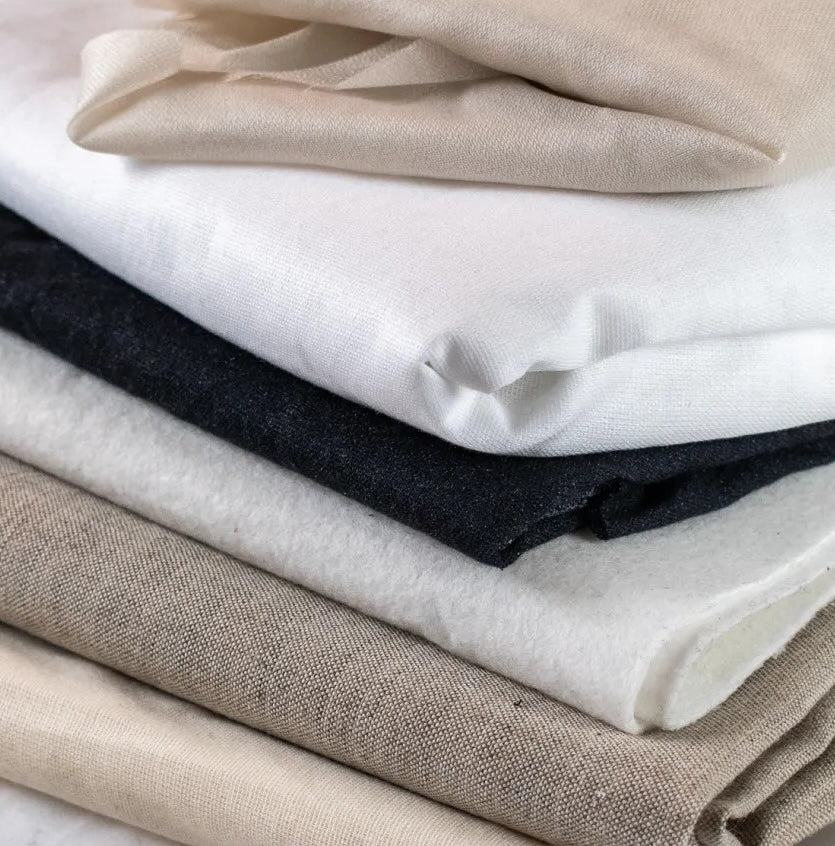Interfacing, Interlining, Underlining, and Lining---Knowing the Difference

The world of linings and interlinings can sometimes be mysterious, and because of that, can often be an afterthought. That's why, when our POP-UP Britex sponsor Apparel Arts ran an article explaining the differences between these unique layers, we asked if we could share it on the Britex Blog. Read on and let us know if you found it helpful!
Interfacing, interlining, underlining, and lining help shape and support a garment. However, they all play a slightly different role.

Interfacing helps control stretch and adds structure. Interfacing can be knit, woven or a compressed, felted material (Pellon). Interfacing can be fusible or sew-in. There are many fusible interfacings on the market. I recommend researching and choosing 3 to 5 to work with on a regular basis. The fusibles I prefer are Sof-Knit, a light-weight knit that does not change the integrity of a fabric. So-Sheer provides a little more support and stability and is versatile as it works well with most fabrics. I probably use So-Sheer the most. My third go-to fusible is Armo Weft. This interfacing has a fair amount of stiffness and support and I use it for heavier fabrics like denim.

The sew-in interfacings I prefer are silk organza, cotton broadcloth or muslin, rayon challis, or hair canvas (Hymo). I use silk organza for lightweight support, cotton broadcloth or muslin for medium support, and rayon challis for support when you want to maintain a drapey hand (with charmeuse or velvets). Hair canvas is used in tailored garments or with denim. Baste sew-in interfacing to each fashion fabric piece individually in the seam allowance and then treat as one piece.

Interlining provides warmth. Common interlinings are cotton or polyester batting or cotton flannel. Quilted garments have an interlining.
Underlining adds structure and support to a fabric. Every pattern piece in a garment is underlined. Underlining fabrics I use are silk organza, cotton broadcloth or muslin, cotton flannel, rayon challis and hair canvas (cotton batiste and crepe de chine also work well at times.) Silk organza is used when a fabric needs just a little more stiffness. Underline linen to cut wrinkling up to 70% without adding weight. Cotton broadcloth or muslin is often used in between fashion fabric and lining on evening gowns as a foundation to attach boning. Cotton flannel is used in bridal and costumes to absorb perspiration and to keep seams and edges soft and round. Underlining velvet or silk charmeuse with rayon challis or crepe de chine gives support while keeping the drapey hand of these fabrics. The support from challis or crepe de chine helps the fabric skim nicely over the body and aids greatly in reducing slippage while sewing. Underlinings are basted to the fashion fabric pieces and treated as one. Cut all pattern pieces out of fashion fabric and underlining fabric. If you are still confused about the difference between interfacing and underlining (since most of the fabrics are the same), perhaps this will help: Only certain pieces of a garment are interfaced - collars, cuffs, waistbands, plackets, while an entire garment is underlined. Even when a garment is underlined certain pieces will still be interfaced. Underline first, interface second.

Lining protects the fashion fabric from the body. Lining also prolongs the life of a garment as it absorbs most of the wear and tear and it helps the fashion fabric hang better on the body. Lining shows on the inside of a garment while interfacing, interlining and underlining are hidden between the fashion fabric and the lining.















This is an excellent tutorial. I searched in vain for something like this for my last clothing construction class. Would you consider putting it in printable format for use by instructors like me. I would be more than glad to credit Britex, of course. Thank you.
Jane Pease
Culpeper VA
Leave a comment